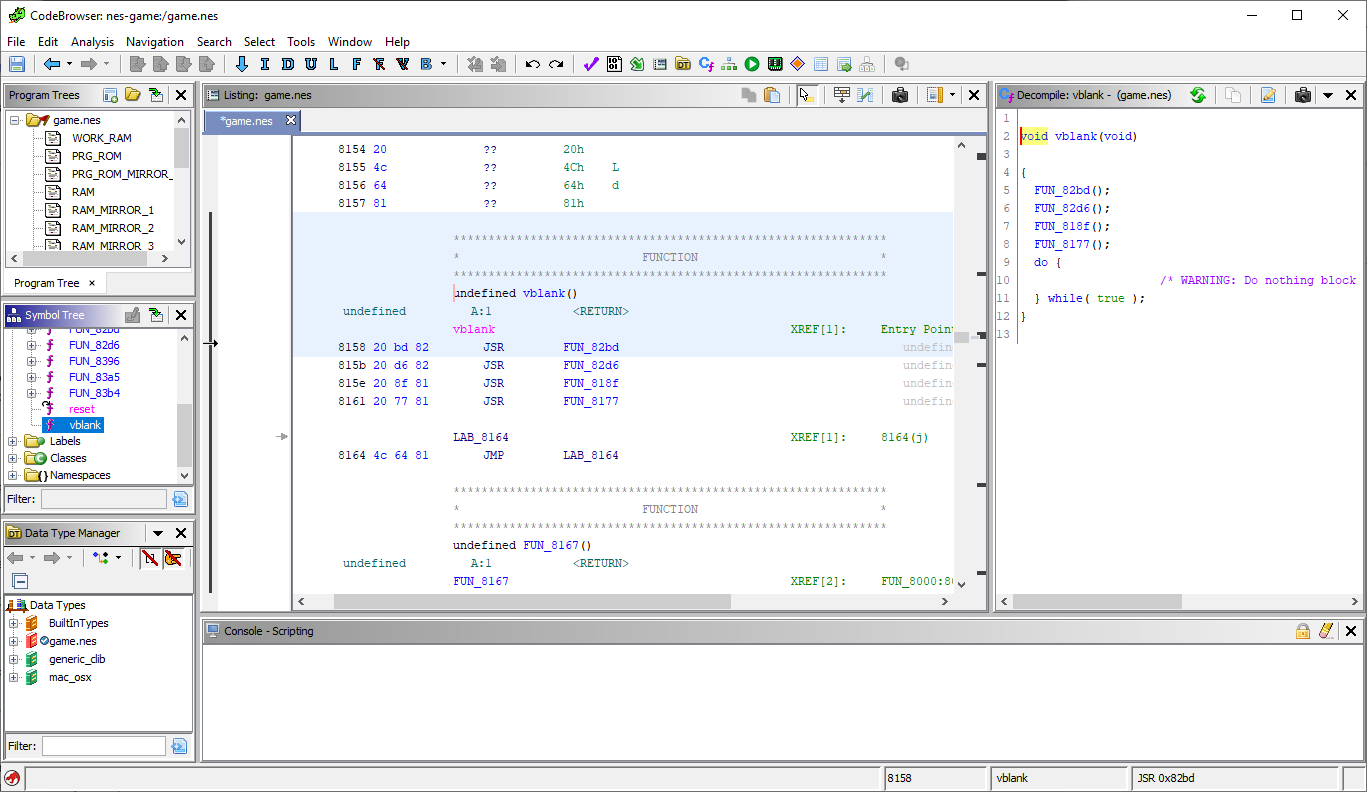A Ghidra extension to support disassembling and analyzing NES ROMs.
-
Import NES ROMs in the iNES format. The following mappers are supported:
-
Add labels and memory blocks in disassembly, making it easier to jump around a disassembled ROM!
- Install a Compatible version of Java and Ghidra (Java 11+).
- Download the latest GhidraNes release. Make sure the release you download matches your Ghidra version!
- Go to "File" > "Install Extensions...". Click "+" in the top-right corner and choose the GhidraNes Zip. Click "OK" to install the extension.
- Restart Ghidra.
- In Ghidra, create a new project by following the wizard under "File" > "New Project...".
- Drag-and-drop an iNES
.nesROM onto the project. Set the format to "NES ROM" and click "OK". - Double-click the ROM in the project to open Ghidra's CodeBrowser.
- Analyze the file when prompted (or go to "Analysis" > "Auto Analyze..."). Leave the settings as default and click "Analyze".
- Done, the game will be disassembled! On the left-hand side, under "Symbol Tree" > "Functions", open
resetto jump to the reset vector (where execution starts), orvblankto jump to the NMI vector (where execution goes during VBlank).
GhidraNes maps each bank of the ROM to its own memory block, but there is no control-flow analysis implemented that handles bank switching automatically. Instead, handling bank switching in the disassembly is a manual process. Take this function for example:
This disassembled function is doing a bank switch: the write to DAT_8000 switches the PRG ROM to bank 0 in this case. Cases like this can be fixed in Ghidra using the following steps:
- Right click the
JMPinstruction - Click "References > Add/Edit (R)"
- Double click the destination operand
- For the "To Address" field, change the left-hand dropdown from "RAM:" to the appropriate memory bank ("PRG0::" for this example)
- Click "Update"
The disassembly should now show a jump to the correct bank:
Note: The
STA,STX, andSTYinstructions can also cause control flow to change if the bank containing the currently-executing code is switched out. It would be good to document a workflow for how to handle this with Ghidra (possibly using the "Fallthrough" mechanism?)
- Install Java and Ghidra.
- install Eclipse.
- Install the GhidraDev Eclipse plugin. Instructions can be found in your Ghidra install directory, under
Extensions/Eclipse/GhidraDev/GhidraDev_README.html. - In Eclipse, open the GhidraNes repo by going to "File" > "Open Projects from File System...". Click "Directory", then choose this repo (the top-level folder containing this
README.mdfile and theGhidraNessubdirectory). Finally, click "Finish". - Open "GhidraDev" > "Link Ghidra...". Add your Ghidra installation, click "Next >", then select the "GhidraNes" as the Java project. Click "Finish".
- Go to "Run" > "Run As" > "Ghidra" to run Ghidra with the GhidraNes extension.
NOTE: Ensure the GhidraNes Eclipse project is set up with the earliest version of Java that should be targeted. Using a later version of Java can cause compatibility issues!
- Install Gradle (with SDKMAN, this can be done with
sdk install gradle). - In Eclipse, open "GhidraDev" > "Export" > "Ghidra Module Extension...". Choose "GhidraNes" as the project, click "Next >", then choose "Local installation directory:" and browse to your Gradle installation dir (with SDKMAN, this will be at
~/.sdkman/candidates/gradle/$GRADLE_VERSION). Click "Finish". - The built zip file will be saved in the
GhidraNes/dist/directory. See the "Installation" section for details on installing the built zip.
- Install Java and Ghidra.
- Configure the JDK settings in your editor.
- For VSCode: Follow the official "Getting Started with Java in VS Code" guide.
- Copy the
GhidraNes/gradle.properties.examplefile toGhidraNes/gradle.propertiesand configure Ghirda's installation directory as needed. - Import the GhidraNes repo as a Java project (the top-level folder containing this
README.mdfile and theGhidraNessubdirectory).
- Move to the inner
GhidraNessubdirectory:cd GhidraNes/GhidraNes - Run
gradle buildExtension- If the
gradle.propertiesfile hasn't been set up, properties can be passed to Gradle directly, e.g.gradle buildExtension -PGHIDRA_INSTALL_DIR=/home/user/ghidra_10.2.2_PUBLIC
- If the
- The built zip file will be saved in the
GhidraNes/dist/directory. See the "Installation" section for details on installing the built zip.


